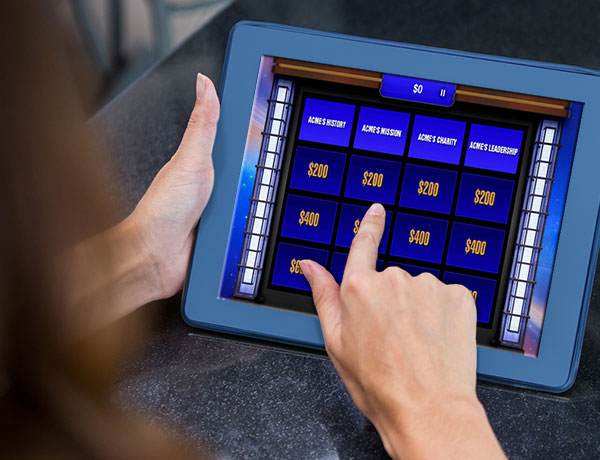First impressions count. If you meet a person, and immediately think, “Wow, that person is fun!” you’re more likely to initiate a conversation. The same goes for onboarding – if the first impression of your company a new hire gets of dull and boring training, what thoughts might they have? Hint – you probably don’t want your new hires to end their first day thinking, “What in the world have I gotten myself into?”
Using Games in the Stages of Onboarding
You can use games in your onboarding training to kick things up a notch. Here are ways you can use games in each stage of onboarding.
New Hire Orientation
This is usually the first stage of onboarding. Since New Hire orientation is mostly made up of a presentation of facts (this is the company’s market position, this is a list of employee benefits, etc), it’s a great place for games like Trivia, JEOPARDY!®, or Wheel of Fortune. Use them to make the boring recall of facts come to life.
Role-Specific Training
This part of new-hire training tells company neophytes how to do their jobs, what systems they will be using in those jobs, and what standards they need to meet. You could use fact-recall games here too, but it’s also a great place for games like Scenarios or Detective that lend themselves to modeling customer service and problem-solving skills.
Shadowing and Mentoring
In this phase, new hires begin actively participating in the team’s work by first shadowing experienced team members, and later working under supervision. It’s a very good practice to hold training to address gaps in knowledge and debrief. Scenario and Detective once again are a great fit.
Consider polling new hire cadres to find problematic scenarios to use in these activities – this will go a long way toward making the training truly useful for the new recruits.
Using Gamification
In addition to adding games, you can use gamification to make your onboarding training stick. Remember that gamification is using game mechanics in non-game environments like training. Some elements you could add to your training include:
- Points: One way of implementing this is to add experience points. The student starts with no points, and as they work through the content, accumulate points.
- Leaderboards: In conjunction with adding experience points, leaderboards are a good option also. These don’t have to be high-tech; something as simple as a spreadsheet can be effective.
- Badges: Badges are another way to track student achievement, and can also be a simple implementation.
- Rewards: Some examples of rewards are gift certificates and company swag. There are other tools in the “rewards” toolbox that you can use in conjunction with each other.
Gamification is a deep pool and this is just a toe in the water. It’s a good idea to decide on an overall strategy and also maybe a theme. Make sure the theme feels related to the actual training. It’s counterproductive to just throw a pirate theme in there when it has nothing to do with the actual training.
One final caveat about gamification – it’s important to know how your learners are motivated because not all of them will respond to points, leaderboards, and badges. Do your research and know your audience.
Games and gamification can help make your new hire onboarding experience more interesting, more rewarding, and more engaging. It requires some overall planning and may involve some retooling, but it’s a great idea to make your onboarding an adventure for your new hires!
If you’d like to learn more about adding games and gamification to your onboarding, schedule a 1:1 demo today!


